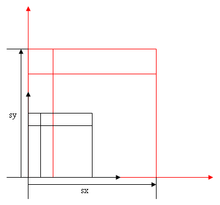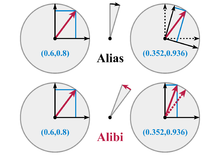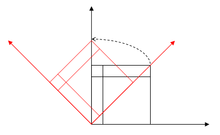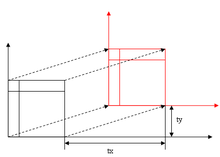Geometric transformation
In a coordinate transformation, the coordinates of a point in one coordinate system are used to calculate its coordinates in another coordinate system. Formally, this is the transformation (transformation) of the original coordinates 

Typical coordinate transformations occur through rotation, scaling, shearing and translation of the coordinate system, which can also be combined.
In general, the new coordinates can be 

A special case of the coordinate transformation is the base change in a vector space.
The transformations considered here, in which the coordinate systems are changed and thus only the coordinates of the points change, while the points themselves remain unchanged, are also called passive or alias transformations, while transformations in which conversely the position of the points changes with respect to a fixed coordinate system are also called active or alibi transformations (see Fig.).

Coordinate transformation with object assumed to be at rest (left) or coordinate system assumed to be at rest (right)
Linear transformations
See also: Linear mapping
In linear transformations, the new coordinates are linear functions of the original ones, i.e.

This can be compactly represented as a matrix multiplication of the old coordinate vector 


The origin of the new coordinate system coincides with that of the original coordinate system.
Rotation
An important type of linear coordinate transformations are those in which the new coordinate system is rotated around the origin of the coordinates (the so-called "alias transformation" in the adjacent graphic). In two dimensions, the only parameter is the angle of rotation; in three dimensions, on the other hand, an axis of rotation that is not changed by the rotation must also be defined. The rotation is described in both cases by a rotation matrix.
Example
Consider two three-dimensional Cartesian coordinate systems 






In matrix notation, the inverse rotation matrix for this rotation of the coordinate system gives:
Scaling
Scaling changes the "units" of the axes. That is, the numerical values of the coordinates 

The parameters of this transformation are the 

The matrix 

Shear
During shear, the angle between the coordinate axes changes. Therefore, in two dimensions there is one parameter, and in three-dimensional space - three parameters.

Scaling

Shear

Rotation of a coordinate system with respect to a vector considered to be at rest and of a vector with respect to a coordinate system considered to be at rest

Counterclockwise rotation of the coordinate system
Affine transformations
See also: Affine mapping
Affine transformations consist of a linear transformation and a translation.
If both coordinate systems involved are linear, (i.e. in principle given by a coordinate origin and uniformly subdivided coordinate axes), then an affine transformation is present. Here the new coordinates are affine functions of the original ones, thus
This can be compactly written as matrix multiplication of the old coordinate vector 



The translation is a special case of an affine transformation where A is the unit matrix.
Displacement (Translation)
Two coordinate systems 








Postponement
Search within the encyclopedia














